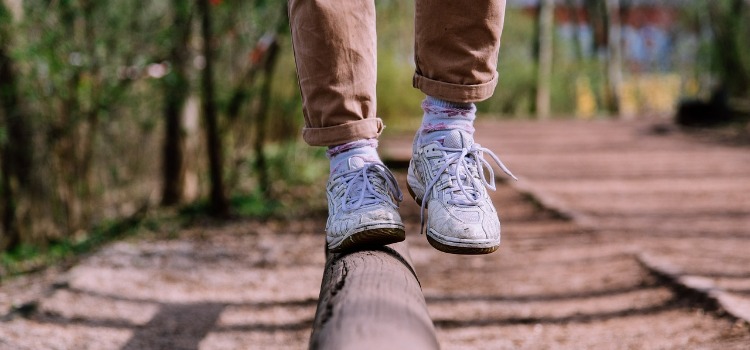Benefits of balance: why is it important?
Did you know that doing activities that improve your balance is just as important for your health as other types of exercise? Being able to balance helps us in many ways – most of which you probably don’t even think about from day to day. Recent research has shown that as we get older, our ability to balance may even have an impact on how long we live.
Here, I’ll explain why balance is important for fitness and health, throughout your life.

Benefits of good balance
Balance basically means being able to stay upright and steady, whether you’re still or moving. We all know that physical activity, in any form, is good for our general health. But being able to balance – along with muscle and bone strength – underpins all physical activities we do. Whether it’s getting dressed in the morning, taking the dog for a walk or running a marathon, you need to be able to balance.
Balance in older age
As we age, our ability to balance gradually declines. This can happen more quickly if you don’t keep active. As you get older, poor balance can also increase your risk of injuries caused by falls. And the older you get, the more likely falls will lead to serious injury and disability.
Having poor balance also acts as a marker for other health problems. These include problems with memory and thinking skills. And some studies have associated not being able to perform simple balance tests with shorter life expectancy.
The good news is it’s never too late to make a change. Evidence shows that doing some form of balance training – even later in life – can improve balance and reduce your risk of falls.
Guidelines in the UK recommend that older adults (aged 65 years and older) should take part in balance activities on at least two days a week. This should be alongside activities for muscle strength and flexibility, and aerobic exercise.
Balance throughout life
Balance isn’t just something to think about when you’re older. Balance activities can help to improve your overall physical ability at any age. If you’re an athlete, they may help to improve your performance and prevent injury. This is why balance activities are routinely incorporated into training programmes for athletes.
Doing exercises to improve balance can help slow the natural decline in muscle and bone strength that starts around middle-age. There are also some key times in life when it can be particularly helpful to work on your balance. These include:
- pregnancy
- menopause
- developing or being diagnosed with a disease, which means you reduce your activity
- retirement
- becoming a carer
- after being in hospital
Improving balance at these points in your life may help to lower your risk of getting ill and injuries.
Balance in sport
So, how can you improve your balance? Certain sports and activities are particularly good for balance. Examples include:
- ball games, like cricket
- racquet sports, like tennis
- resistance training, including lifting weights
- aerobics or circuit training
- Nordic walking (a walking technique that uses poles to work your upper body)
- running
- cycling
- dancing
- yoga
- Tai Chi
Taking part in these activities may help with other elements of physical fitness too. These include improving muscle strength, bone health and aerobic capacity.
Balance exercises
Exercises that focus just on balance are also a good way to improve your balance. Below are some quick and easy examples. These can be safer and more practical for older people and those unable to do other forms of exercise. But they may also be useful for anyone wanting to incorporate balance training into their everyday life.
- One-legged stand. Stand on one leg, raising your other leg, for up to 10 seconds.
- Sit-to-stand. Stand up from a seated position and repeat up to five times in a row. Start using one hand to push off if you need to, progressing to no hands when you’re ready.
- Heel/toe raises. Using a chair or table for support, slowly raise your heels off the floor so you’re standing on your toes. Repeat the exercise raising your toes, so that you stand on your heels. As you progress, try extending how long you hold the raise for. You can also try taking some steps on your toes or heels.
- Sideways walking. Stand with your feet together, and slowly step sideways. Then move your other foot to join it. Try performing 10 steps in each direction.
- Heel-to-toe walk. Walk with one foot placed directly in front of the other, so the toes of one foot touch the heel of the other. Use a wall for support while you build confidence.
It’s always a good idea to start slow, and use support such as a sturdy chair, table or a wall to begin with. You can reduce this as your balance and confidence improves. And if you have health problems or have previously had a fall, ask your doctor or physiotherapist for advice first.
Are you interested in learning more about your health? Discover more about our range of health assessments.
-
Sources Sources
- Muscle and bone strengthening and balance activities for general health benefits in adults and older adults. Summary of a rapid evidence review for the UK Chief Medical Officers’ update of the physical activity guidelines. Public Health England. gov.uk, published July 2018
- Physical activity guidelines: UK Chief Medical Officers' report. gov.uk. www.gov.uk, published 7 September 2019
- Araujo CG, de Souza E Silva CG, Laukkanen JA, et al. Successful 10-second one-legged stance performance predicts survival in middle-aged and older individuals. Br J Sports Med 2022;56(17): 975-980. doi: 10.1136/bjsports-2021-105360
- Howe TE, Rochester L, Neil F, et al. Exercise for improving balance in older people. Cochrane Database Syst Rev 2011;(11): CD004963. doi: 10.1002/14651858.CD004963.pub3
- Skelton DA, Mavroeidi A. How do muscle and bone strengthening and balance activities (MBSBA) vary across the life course, and are there particular ages where MBSBA are most important? J Frailty Sarcopenia Falls 2018;3(2): 74-84. doi: 10.22540/JFSF-03-074
- Brachman A, Kamieniarz A, Michalska J,et al. Balance training programs in athletes - a systematic review. J Hum Kinet 2017;58: 45-64. doi: 10.1515/hukin-2017-0088
- Campbell AJ, Robertson MC, Gardner MM, et al. Randomised controlled trial of a general practice programme of home based exercise to prevent falls in elderly women. BMJ 1997;315(7115): 1065-9. doi: 10.1136/bmj.315.7115.1065
- Tiedemann A, Sherrington C, Close JC, et al. Exercise and Sports Science Australia position statement on exercise and falls prevention in older people. J Sci Med Sport 2011;14(6): 489-95. doi: 10.1016/j.jsams.2011.04.001
About our health information
At Bupa we produce a wealth of free health information for you and your family. This is because we believe that trustworthy information is essential in helping you make better decisions about your health and wellbeing.
Our information has been awarded the PIF TICK for trustworthy health information. It also follows the principles of the The Information Standard.

More mental health and wellbeing articles
Did you find our advice helpful?
We’d love to hear what you think. Our short survey takes just a few minutes to complete and helps us to keep improving our healthy lifestyle articles.
Legal disclaimer
This information was published by Bupa's Health Content Team and is based on reputable sources of medical evidence. It has been reviewed by appropriate medical or clinical professionals and deemed accurate on the date of review. Photos are only for illustrative purposes and do not reflect every presentation of a condition.
Any information about a treatment or procedure is generic, and does not necessarily describe that treatment or procedure as delivered by Bupa or its associated providers.
The information contained on this page and in any third party websites referred to on this page is not intended nor implied to be a substitute for professional medical advice nor is it intended to be for medical diagnosis or treatment. Third party websites are not owned or controlled by Bupa and any individual may be able to access and post messages on them. Bupa is not responsible for the content or availability of these third party websites. We do not accept advertising on this page.







